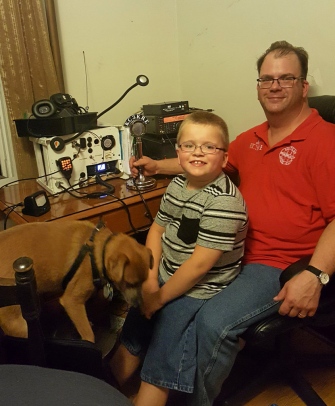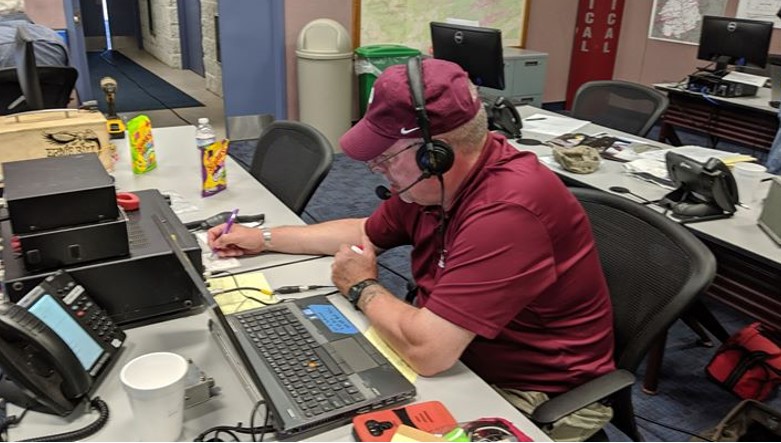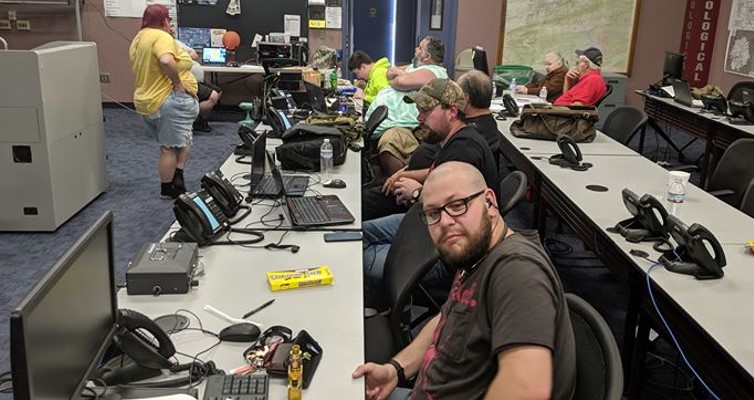



Ham Radio offers fun hobby for a serious purpose Jack Smiles / published: September 29, 2019 Courtesy Sunday Dispatch - Pittston
 When John Orluk KC3KRE isn’t busy working at Schott, volunteering as an EMT or firefighter, or spending time with his wife, Christine, and son, Alexander , 8, he visits friends in Michigan, Colorado, Minnesota, Nova Scotia, Guantanamo Bay, Croatia and Italy without leaving his home in Avoca. Orluk, 46, talks to people from around the U.S. and world without using internet or cell phone. Instead, he uses his 100-watt radio and 60-foot wire antenna. Orluk is an amateur, or ham, radio operator. Orluk said he has been interested in ham radio since he was a teenager.“I wanted to get an amateur license in high school, but back then you had to do a Morse code test and I had no interest in that,” he explained. Life happened, and though he kept up his interest in radio as an EMT with Avoca Ambulance, he didn’t pursue an amateur radio license until two years ago. “I saw a post on Facebook where the Murgas Amateur Radio Club was testing for the FCC. That sparked my interest. They have people called VEs, who do testing sessions,” Orluk said. With the Morse code requirement dropped, Orluk took the test. VEs are volunteer examiners who administer the FCC licensing exams for three levels — technician, general and amateur extra. Each level allows users to operate at more frequencies. An example of a question on the 235-question test is: “What type of amateur station simultaneously retransmits the signal of another amateur station on a different channel or channels?” The answer is a repeater station. If the test sounds daunting, the answers can be researched online. While ham operating can be a fun hobby, the FCC oversees the network for a serious purpose — to ensure communication between emergency service providers, government agencies and the public during disasters such as floods or hurricanes, when cell and internet signals are lost. The last time the Murgas Club participated in an ARES (Amateur Radio Emergency Service) drill was when the Susquehanna Steam Station in Berwick shutdown a reactor. The last time the club was activated for a real emergency was during the Bear Creek Tornado in 2017. During an emergency, messages are relayed from Harrisburg to local municipalities and hams maintain communications with the municipalities. During hurricanes, FEMA has a network for communications inland, out of the disaster areas. Also, state law requires amateur radio at checkpoints at marathons. Back to the fun part. Amateur radio operates on three frequencies, HF, UHF, VHF. “With HF,” Orluk said, “you can bounce a signal off the ionosphere and talk to people around the world.” In his experience, most ham operators speak English. A ham operator in Italy broadcasts through a 1,000 foot tower. “You can hear him as clear as two people at a table can hear each other,” Orluk said. Orluk said he has a friend who spoke with King Hussien of Jordan more than 20 years ago. What did they talk about? “The king wanted to know the weather,” Orluk said. He said the weather is a common topic. Hams also like to ask about each others’ lives, what it’s like where they live and their radio setups. Some hams use Earth-Moon-Earth to connect, which is possible as long as both can see the moon. Orluk said his wife thought he was a little crazy when he started communicating with people around the world. “It grew on her. She even encouraged me to take it camping, so I didn’t have to talk to her,” he said with a chuckle. A VHF-UHF portable set, which can pick up signals from repeaters, can be had for as little as $25. A repeater retransmits weak signals at a higher power, so the signal can cover longer distances without degradation. “The sky’s the limit,” Orluk said about the cost of setups. “They can go $5,000 and up. I bought a used one and got a very good deal for around $500.” His microphone has a cool retro look and is about 35 years old; the radio, about 20. “It is fun. I do enjoy it and I recommend it. It’s a thrill to be able to talk to someone on the other side of the world, plus do good.” The Murgas Club is named after the Rev. Joseph (Josef) Murgas, a priest and communications pioneer. He is considered the first to successfully transmit over land with an experimental broadcast from Wilkes-Barre to Scranton in 1905. For information, visit murgasarc.org. jsmiles@pittstonprogress.com |
Drones - The Luzerne County Quarterly Training...
I just have to say that this was one of the most interesting of Dave Elmore's (Deputy Coordinator/Training Officer/KC3IMJ) Quarterly Training Efforts. He has had a lot of good ones but this one really had the audience's attention.
We had quite a few attendees along with members of the Murgas ARC but I think it is safe to say that LCARES was more than well represented at the training. That is too bad too. The "Sit on your hands, Stay at home" crowd missed a really interesting session on drones, unmanned aerial vehicles, air robots, whatever you want to call them.
Dave persuaded the Lehigh County Drone Response Team to travel to Luzerne County to demonstrate the tools of their trade and explain what they can and in some instances cannot do with machines. They had everyone's attention as the pictures will attest to.
|
Luzerne County ARES® Display at the West Hazleton Fire
Company...
- On July 29th 3 members of the LCARES traveled to West Hazleton, PA, to
display some of the communications capabilities of ARES.
KC3NAJ, KC3HLT, and K3NDB along with K3NDB's junior Op were in
attendance. Reports have it that the K3NDB Junior Op made out like a
bandit with the give away swag. |
Winlink Station - Left to Right KB3VS, N1ZZZ(seated), WA2BBS , Unidentified, N3XMB ,KB3ACZ ,N3RN ,AB3ZI
|
 KC3MJW,KC3HLS, and others at Field Day 2019 working 20,15,and 10 meters using FT8 KC3MJW,KC3HLS, and others at Field Day 2019 working 20,15,and 10 meters using FT8

| Courtesy Citizens Voice, July 8, 2019  Dave Scherbenco / Staff Photographer Dave Scherbenco / Staff Photographer
Bob of Sweet Valley looks over a large selection of radio antennas
during the Murgas Radio Club Hamfest at the Polish American Veterans
Club in Plains Twp. on Sunday.
PLAINS TWP. — Old radio equipment and amateur radio enthusiasts of all ages
filled the grounds of the Polish American Veterans club for the 40th annual
Hamfest on Sunday.
The event, organized by the Murgas Amateur Radio Club, gave amateur radio
operators a chance to share stories about their mutual obsession, often referred
to as “ham” radio.It also gave them a chance to sell older, unneeded equipment.
Bruce Lordi, of Morris County, New Jersey, was one of the many vendors
He said ham radio has been his hobby for the past 40 years. Technological
advances have improved the quality of receivers and other equipment,
but the basics of radio operation remain the same, he said.
In recent years, Lordi has learned how ham radio operators can help keep
lines of communication open in times of emergency, he said.
During Superstorm Sandy in 2012, electric power was out for 13 days at
Lordi’s house and for many of his neighbors. Cellular and landline phone
service was also interrupted.
Emergency management officials kept in touch with one another through
ham radio, which uses a frequency spectrum that is not disrupted by weather
conditions, Lordi said.
The chance to help in an emergency, perhaps to the point of saving lives,
motivates many ham operators, according to Lordi.
“People want to help out their communities,” he said.
A vendor at a nearby table described ham radio as “a hobby that’s
also a service.” It’s a hobby that gives “hams” the chance to speak with fellow radio
operators anywhere in the world.
Tom Dougherty, 86, of Tunkhannock, learned to operate radio equipment
when he served in the U.S. Army during the Korean War.
“They gave you a test and told you what you were good at,” he said.
Dougherty proved to be good at electronics and especially at radio operation.
He helped his unit keep in touch with other Army units in the war zone. He
also relayed messages from soldiers to loved ones back home, he said.
Dougherty maintained his passion for amateur radio after resuming civilian life.
For more than 60 years he has talked to ham radio operators in almost every
nation on Earth. There is usually no language barrier, as the vast majority
of operators speak English, he said.
Some of his favorite conversations have been with radio operators on expeditions
in remote locations including the South Pole, he said.
While he no longer gets to as many gatherings of ham radio enthusiasts as
he once did, Dougherty says he has no plans to quit the hobby.
“As long as I’m here I’ll be on the air,” he said.
For information on the Murgas Amateur Radio Club, see: http://murgasarc.org/.
July 4, 2019 Contact the writer:emark@citizensvoice.com 570-821-2117
|
Click on the QSL Card to e-mail The Murgas ARC Yahoo! group.